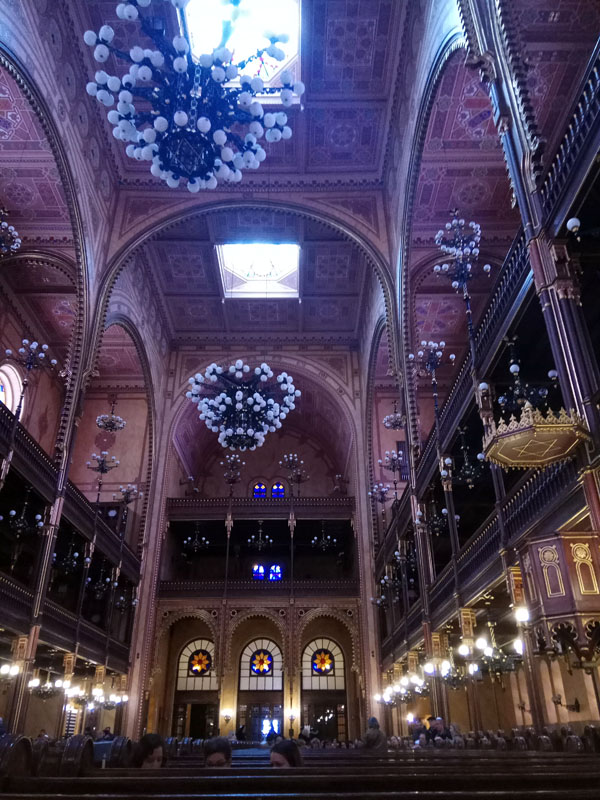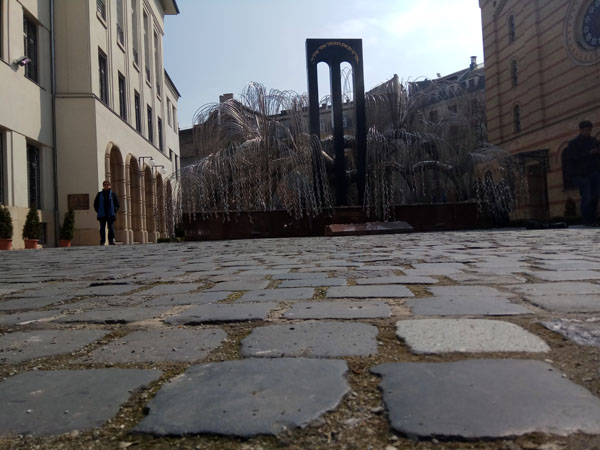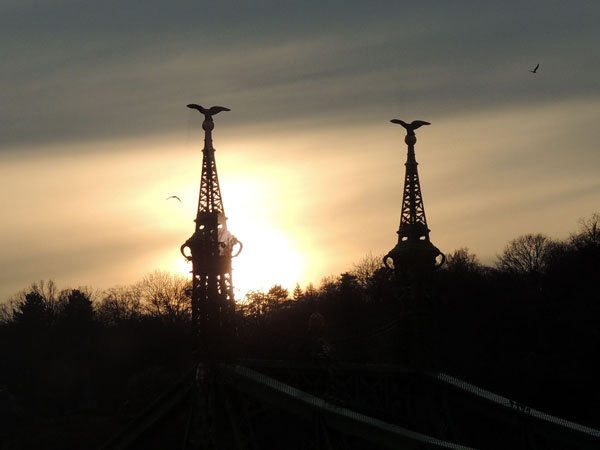|
|
|
matzo in Budapest
Tuesday, March 27 2018
location: room 342, Danubius Gellért Hotel, Budapest, Hungary
After a lingering breakfast on a tier of the multi-story atrium outside the Gellért dining room, Gretchen and I packed up our stuff and moved out of our room, leaving our bags at the Gellért while we ran some errands before boarding the boat where we would be spending the next eleven days cruising the Danube in vegan luxury. Our checklist included some sexual lubricant for Gretchen (hysterectomies and advancing age have their downsides), matzo (for the upcoming week of Passover, which would be spent entirely on the boat) and perhaps sunglasses (Gretchen had forgotten to bring any, and, unlike me, she has difficulty enjoying the outdoors without them). We also wanted to check out Budapest's biggest synagogue.
These errands took us across the Liberty Bridge and then northward on Múzeum korut. I saw a number of dogs, and so looked up what "dog" is in Hungarian. It's "kutya," which is close enough to "cute" for me to remember. That being said, I was finding it hard to appreciate Hungary as much as I otherwise would've, knowing that its in the process of gradually becoming an authoritarian state run by someone given to making implicitly anti-semetic statements.
We'd found the pharmacies ("gyogyszertar") useless for providing sexual lubricant (though they did have pet medications), but Gretchen had found an actual sex shop very near the synagogue she wanted to visit. Well, she'd found it on her phone, but tromping around the neighborhood where it supposedly could be found initially proved fruitless. Eventually I took over the search, and it led me to a grimy door with almost no signage. It was the place. We had to be buzzed in and then climb several flights of stairs. And then we were there, a genuine Hungarian sex shop. There was a big room devoted just to pornographic movies, perhaps for older people who don't know how to work the internet. There was also a glass case full of dildos and various rubber and plastic objects designed to resemble the fuckable parts of a human anatomy. The only other customers when we arrived were a youngish couple shopping for a dildo. The lubricant was a bit overpriced, but there it was.
Nearly across the street was the Dohány Street Synagogue, a beautifully-tiled structure that looked a Turkish mosque. It is, it turns out, the largest synagogue in Europe and the second largest in the world. We paid our admission, stood in line, and then eventually entered the main space of the mosque, which was on the scale of the sort of cathedral one might want to walk around in in Rome. Unusually for a synagogue, it featured many churchlike details. These included a pipe organ, lavish (though image-free) decoration, and two of those small portable spiral staircases topped with mini-pulpits, which in a synagogue serve no purpose). We soon found ourselves in the pews behind a union jack, where a guide, an older middle-aged man, gave us the history of the place in English (there were other sets of pews behind other flags where the history was given in other languages). He knew a lot and leavened what he said with a dash of delightful humor, though as he did so, he kept admonishing men passing by to please cover their heads. Gretchen had loaned me her knit cap (which included pro-vegan propaganda), so, unusually, I was not among the admonished. After we learned the history of the place and of the assimilatory impulses that caused resulted in its being so churchlike, our guide took us out to a side yard, where the remains of at least three thousand Holocaust victims had been buried in a mass grave that was now festooned with memorial plaques. During World War II, the synagogue had been on the edge of the Jewish ghetto, whose horrors didn't fully arrive until a few months before the end of the war. The winter of 1944-1945 was unusually cold, and many starved in the ghetto. The bodies weren't buried until after the Soviets arrived. There were other memorials in the back of the synagogue, both to those who had died and to those who had done what they could to save people. The most striking of these was a stainless steel willow tree, whose leaves consisted of the names and death camp tattoo numbers of the dead. There was also an entirely separate synagogue in the side yard near the mass grave; it is mostly used in the winter, when the heating cost of the main synagogue become prohibitive.
We went back into the synagogue briefly to take some pictures and listen to some of the presentation by the Spanish-speaking guide. And then we headed off to our next destination: a kosher grocery store, where we bought a huge (~25 ounce) box of matzo, two smaller boxes of rye matzo (we'd never seen that before), two containers of tomato paste, and a bottle of "light" kosher wine (similar to Manischewitz, but only a little over 3% alcohol). I wanted real wine, so next we went to a real wine store and got a bottle of Procupac.
We'd been told our cruise ship, the MS Joy, would be docking north of the Liberty Bridge. But when we went looking for it, none of the ships at those docks had the right name. We were starting to freak out and wonder if Dirk (the cruise director) had fled into the Trump administration with our money. But then, south of the bridge, there she was, the MS Joy. It looked substantially similar to the boat we'd taken up the Rhone, though it was slightly smaller. We hurriedly boarded, checked in, and dropped off our wine and matzo in our room, a palatial 300 square foot unit on "the diamond deck." The room came complete with a couch and a little table. The windows opened, though (unlike the boat we'd taken up the Rhone), there was no balcony beyond it. The bathroom was bigger than it needed to be, and for some reason there was a walk-in closet. (We'd originally signed up for a smaller room, but we got this one at a slight discount after Dirk called and upsold it to us.)
The mighty Gellért Hotel was just across the Danube and visible from our room in the MS Joy. We were comfortable, but wanted to start the next leg of our adventure. So went back and retrieved our bags. Then we had a light pasta-based first lunch in the MS Joy's lounge. Unlike the cruise on the Rhone, alcohol on this cruise would not be free. Nevertheless, I ordered a beer (it came to four euros). It was whatever the boat's token Hungarian beer happened to be, and it struck me as not all that much better than a Budweiser.
The cruise had advertised itself as having free WiFi, so when we learned that, no, the plan was for us to pay twenty euros for internet access, Gretchen pulled Dirk aside and was like, look Dirk, our room upgrade cost more than you'd said it would, and now this? He quickly backed down, and our internet for this cruise would be free.
Then it seemed like, unlike the cruise up the Rhone, there was no hot drink machine! Were we going to be nickel-and-dimed for every coffee and tea as well? We were about to mutiny over this issue, but then Gretchen discovered that the boat had a second, smaller, restaurant at the back of the boat on our floor, and there was a coffee-making robot there. Mutiny averted!
[REDACTED]
We hung out in our wonderful room for awhile and eventually made it down to the dining room for the cruise's first dinner. At around this time, the ship weighed anchor, we cruised north past the Parliament (lit up like an orange Christmas tree), made a U-turn, and began navigating south.
At dinner we were joined by Boris, a squirrely waifish guy, and Carrie, a nondescript American. They knew each other and were on this cruise to provide services to people like us. Boris would be teaching how to prepare raw food (though he said he doesn't always eat raw, or even vegan, himself) and Carrie would be leading morning yoga classes. Then we were joined by Sara from London and Lily from Hong Kong with an older Dutch woman who mostly talked about how hard of hearing she is. Though she looked to only be in her 20s, I tried to interest Lily in working for my employer; she seemed to know the things she would need to know for the job I had in mind. As for the meal, I don't really remember much about it other than that it was, as dinners are on a cruise ship, multi-course and a bit lingery for my tastes.

Inside the Dohány Street Synagogue. Click to enlarge.

The courtyard behind the Dohány Street Synagogue, with the willow tree memorial in the background. Click to enlarge.

Susnet over the Liberty Bridge. Click to enlarge.
For linking purposes this article's URL is:
http://asecular.com/blog.php?180327 feedback
previous | next |


